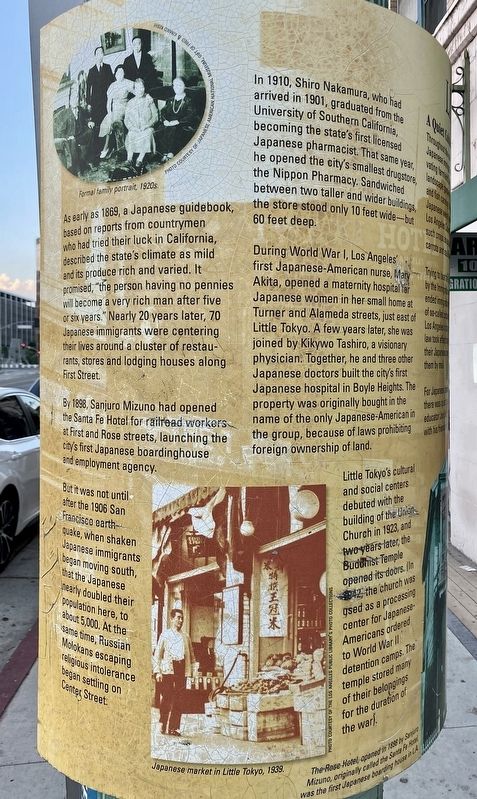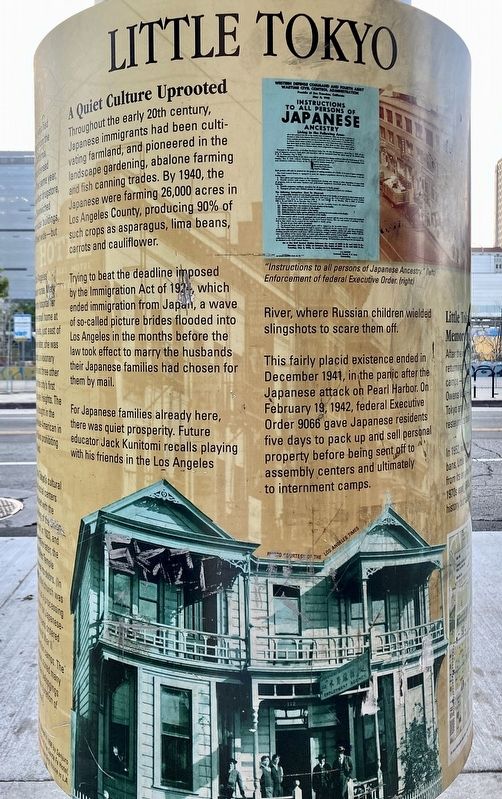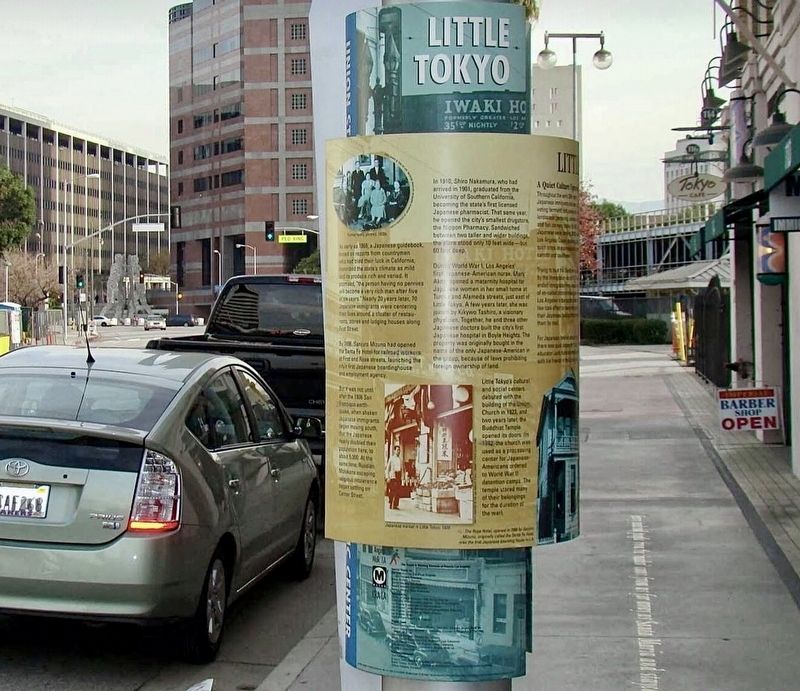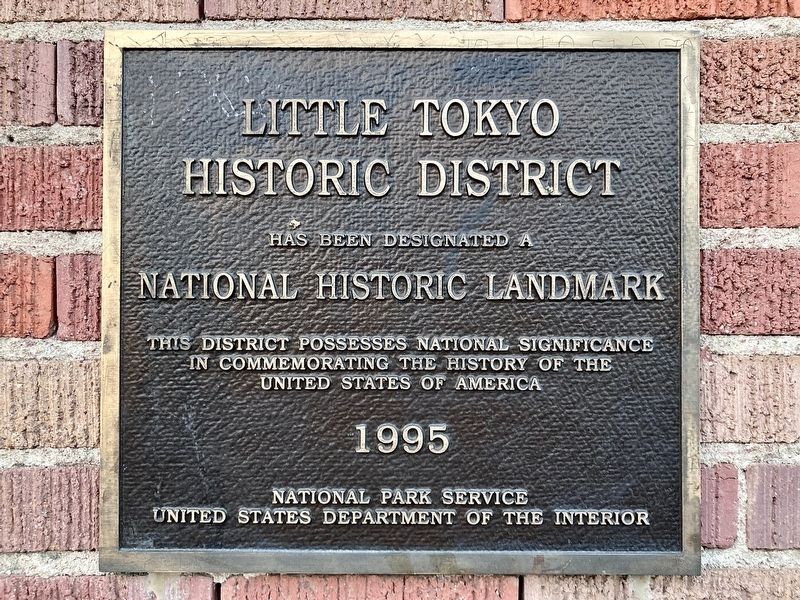Downtown Los Angeles in Los Angeles County, California — The American West (Pacific Coastal)
Little Tokyo
As early as 1869, a Japanese guidebook, based on reports from countrymen who had tried their luck in California, described the state's climate as mild and its produce rich and varied. It promised, "the person having no pennies will become a very rich man after five or six years." Nearly 20 years later, 70 Japanese immigrants were centering their lives around a cluster of restaurants, stores and lodging houses along First Street.
By 1898, Sanjuro Mizuno had opened the Santa Fe Hotel for railread workers at First and Rose streets, launching the city's first Japanese boardinghouse and employment agency.
But it was not until after the 1906 San Francisco earthquake, when shaken Japanese immigrants began moving south, that the Japanese nearly doubled their population here, to about 5,000. At the same time, Russian Molokans escaping religious intolerance began settling on Center Street.
In 1910, Shiro Nakamura, who had arrived in 1901, graduated from the University of Southern California, becoming the state's first licensed Japanese pharmacist. That same year, he opened the city's smallest drugstore, the Nippon Pharmacy. Sandwiched between two taller and wider buildings, the store stood only 10 feet wide — but 60 feet deep.
During World War I, Los Angeles’ first Japanese-American nurse, Mary Akita, opened a maternity hospital for Japanese women in her small home at Turner and Alameda streets, just east of Little Tokyo. A few years later, she was joined by Kikywo Tashiro, a visionary physician. Together, he and three other Japanese doctors built the city's first Japanese hospital in Boyle Heights. The property was originally bought in the name of the only Japanese-American in the group, because of laws prohibiting foreign ownership of land.
Little Tokyo's cultural and social centers debuted with the building of the Union Church in 1923, and two years later, the Buddhist Temple opened its doors. In 1942 the church was used as a processing center for Japanese-Americans ordered to World War II detention camps. The temple stored many of their belongings for the duration of the war.
A Quiet Culture Uprooted
Throughout the early 20th century, Japanese immigrants had been cultivating farmland, and pioneered in the landscape gardening, abalone farming and fish canning trades. By 1940, the Japanese were farming 26,000 acres in Los Angeles County, producing 90% of such crops as asparagus, lima beans, carrots and cauliflower.
Trying to beat the deadline imposed by the Immigration Act of 1924, which ended immigration from Japan, a wave of so-called picture brides flooded into Los Angeles in the months before the law took effect to marry the husbands their Japanese families had chosen for them by mail.
For Japanese families already here, there was quiet prosperity. Future educator Jack Kunitomi recalls playing with his friends in the Los Angeles River, where Russian children wielded slingshots to scare them off.
This fairly placid existence ended in December 1941, in the panic after the Japanese attack on Pearl Harbor. On February 19, 1942, federal Executive Order 9066 gave Japanese residents five days to pack up and sell personal property before being sent off to assembly centers and ultimately to internment camps.
As the Japanese were bundled out of Little Tokyo, African-Americans moved in. Throughout the war the area was known as Bronzeville, a place where late-night jazz clubs thrived.
Little Tokyo in Memory and Movies
After the war's end, many of those returning from different army relocation camps — among them Manzanar in the Owens Valey — opted not to live in Little Tokyo and longer, but to open shops and restaurants there.
In 1952, with the repeal of immigration bans, Little Tokyo began to grow south from its original boundaries. In the 1970s and 1980s, Hollywood and history buffs discovered Little Tokyo.
Raymond Chandler fans could dine at the Far East Café, a Depression-era Chinese joint and former hardware store, where Philip Marlowe was having lunch when he would recall, "a dark shadow fell over my chop suey." Its high, wood-paneled booths and naked light bulbs lent authenticity to the 1975 film of the Chandler story "Farewell, My Lovely."
Little Tokyo's history is remembered in a sidewalk art project called "Omoide no Shotokyo," by Sheila Levrant de Bretteville. Brass plaques are embedded in the sidewalk along a stretch of First Street between San Pedro Street and Central Avenue, where 13 buildings were designated a National Historic Landmark in 1995.
Erected 2000 by City of Los Angeles.
Topics. This historical marker is listed in these topic lists: Asian Americans • Industry & Commerce • Settlements & Settlers. A significant historical year for this entry is 1869.
Location. 34° 3.039′ N, 118° 14.433′ W. Marker is in Los Angeles, California, in Los Angeles County. It is in Downtown Los Angeles. Marker is on Judge John Aiso Street just north of 1st Street, on the right when traveling north. Touch for map. Marker is at or near this postal address: 108 Judge John Aiso St, Los Angeles CA 90012, United States of America. Touch for directions.
Other nearby markers. At least 8 other markers are within walking distance of this marker. Union Church (within shouting distance of this marker); Fugetsu-Do (within shouting distance of this marker); The Finale Club (about 300 feet away, measured in a direct line); Aoyama Tree (about 500 feet away); "Go For Broke" (about 500 feet away); Colonel Ellison Onizuka (about 500 feet away); Honor Award Story (about 500 feet away); Hompa Hongwanji Buddhist Temple (about 600 feet away). Touch for a list and map of all markers in Los Angeles.
Also see . . . Angels Walk L.A. Self-guided walking tours of historic neighborhoods in Los Angeles. The Little Tokyo marker is part of the Union Station walk. (Submitted on August 21, 2023.)
Credits. This page was last revised on August 22, 2023. It was originally submitted on August 21, 2023, by Craig Baker of Sylmar, California. This page has been viewed 109 times since then and 44 times this year. Photos: 1, 2, 3, 4. submitted on August 21, 2023, by Craig Baker of Sylmar, California.



